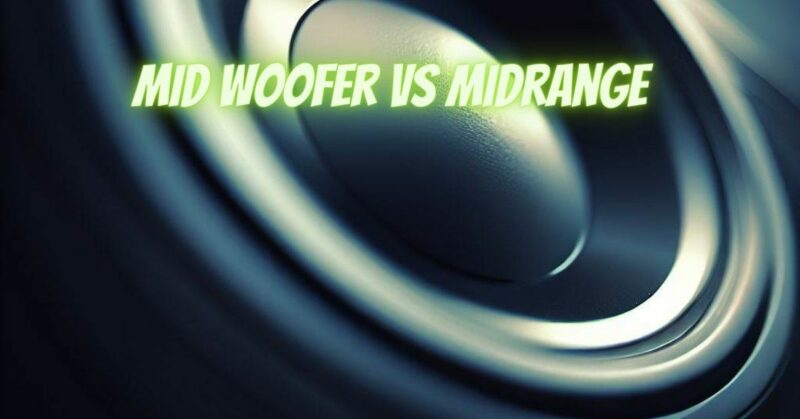When it comes to speaker systems, midrange reproduction plays a critical role in delivering clear and accurate vocal and instrument sounds. Two commonly encountered components in this frequency range are mid woofers and midrange drivers. In this article, we will explore the distinctions between mid woofers and midrange drivers, their specific functions, and how they contribute to the overall sound reproduction in speaker systems.
- Frequency Range and Design: Mid woofers and midrange drivers are designed to handle overlapping frequency ranges, but with some variations. Mid woofers typically cover a wider frequency range, usually from around 100Hz to 5kHz. They are designed to handle mid-bass and lower midrange frequencies. On the other hand, midrange drivers focus on a narrower frequency range, typically from around 500Hz to 5kHz, and specialize in reproducing the critical midrange frequencies with clarity and accuracy.
- Cone Material and Construction: The choice of cone material and construction differs between mid woofers and midrange drivers. Mid woofers often feature larger cones and are built to handle more robust bass reproduction. They may utilize materials like polypropylene, treated paper, or composite blends to strike a balance between stiffness and flexibility. Midrange drivers, in contrast, use lighter and more rigid cone materials, such as woven fabrics, treated paper, or specialized composites, to deliver precise midrange performance.
- Dispersion and Directivity: Midrange dispersion and directivity are important factors to consider in speaker systems. Mid woofers, due to their broader frequency range, typically have wider dispersion characteristics. This means that the sound radiates more evenly in different directions. Midrange drivers, on the other hand, are often designed with controlled dispersion to focus sound energy in a narrower pattern, providing better localization and accuracy for midrange frequencies.
- Crossover and Integration: Proper integration and crossover design are crucial when incorporating mid woofers and midrange drivers in speaker systems. Crossover networks are used to direct specific frequency ranges to the appropriate driver. The crossover point between the mid woofer and midrange driver is carefully chosen to ensure a seamless transition and avoid frequency overlap. Matching the sensitivity and impedance of both components is also important to maintain proper balance and optimize their performance.
- Vocal and Instrument Reproduction: Midrange frequencies contain vital elements of vocal and instrument sounds. Midrange drivers are specifically designed to reproduce these frequencies with accuracy and clarity, ensuring vocals and instruments are well-defined and articulate. Mid woofers contribute to the overall midrange performance by handling the lower end of the midrange spectrum, providing body and warmth to the sound.
- Room Acoustics and Placement: Room acoustics and speaker placement play a significant role in the performance of mid woofers and midrange drivers. The physical environment can influence how sound waves interact, potentially affecting the overall sound reproduction. Experiment with speaker placement, consider room treatments, and address acoustic issues like reflections and resonances to optimize the performance of both mid woofers and midrange drivers in your listening environment.
| Feature | Mid-Woofer | Midrange Speaker |
|---|---|---|
| Frequency range | 200 Hz to 5 kHz | 200 Hz to 3 kHz |
| Size | Typically 4 inches to 6 inches in diameter | Typically 4 inches to 5 inches in diameter |
| Power output | Typically 20 to 100 watts | Typically 10 to 50 watts |
| Purpose | To reproduce mid-range sounds | To reproduce mid-range sounds |
Conclusion:
Understanding the distinctions between mid woofers and midrange drivers is crucial for designing and selecting speaker systems that deliver accurate and balanced sound reproduction. While mid woofers cover a wider frequency range and focus on mid-bass reproduction, midrange drivers specialize in reproducing critical midrange frequencies with precision. By carefully integrating these components, optimizing room acoustics, and ensuring proper placement, you can create a speaker system that excels in reproducing vocals and instruments, providing an immersive and engaging listening experience.


